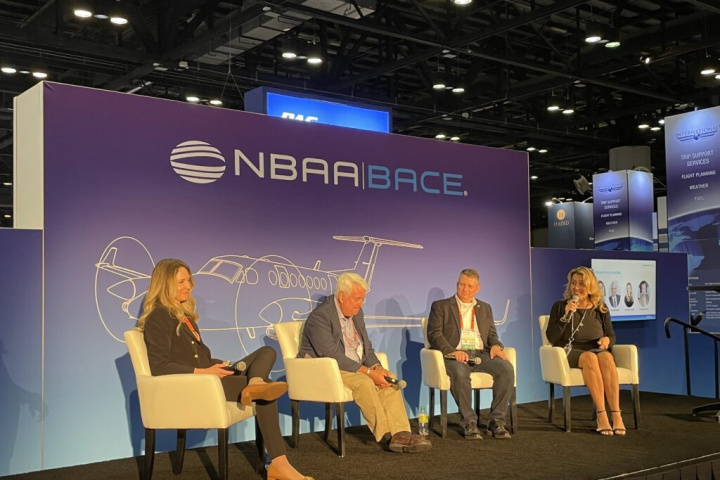From Aviation Today By Jessica Reed

Kristen Costello of DroneUp, Paul McDuffee of Supernal, and Charlton Evans of End State Solutions discussed the challenges facing business aviation flight departments as the advanced air mobility industry takes off. The panel discussion was moderated by Toni Drummond of Global Aerial Management Group. (Photo: Jessica Reed)
ORLANDO, Fla. — Business aviation flight departments need to prepare for advanced air mobility (AAM) operations and related technologies that are emerging. There are many hurdles that the introduction of advanced technologies must overcome, including public acceptance, regulations, and infrastructure requirements.
Panelists at the 2022 NBAA Business Aviation Convention & Exhibition (NBAA-BACE) in October discussed the many possibilities of emerging AAM technologies as well as how to overcome some of the challenges of this industry. The educational session was titled, “Tomorrow’s Flight Department – The Opportunities and Challenges of AAM Integration.”
Kristen Costello, Senior Director of Flight Compliance at DroneUp, remarked that no one could have predicted the rapid growth of the unmanned aircraft systems (UAS) industry when Part 107 was written back in 2016. “What we’re seeing now is a rapid evolution,” Costello stated. “What used to be the standalone person with the Mavic going out and doing inspections is now transitioning to a phase where you’re seeing large-scale delivery operations, and some of these departments are even pursuing 135.”
She added that the current challenges the UAS industry faces will inform the AAM industry’s growth. In particular, air traffic management for UAS, or UTM, will inform developments in the urban air mobility (UAM) industry in terms of regulatory challenges and the collaborations that will be necessary to pave the way for these new aircraft and technologies. For example, Costello noted, the FAA is currently conducting research and using UTM concepts to develop an approach to UAM.
Sustainability is a primary focus for AAM manufacturers, stated Paul McDuffee, an executive operations analyst at Hyundai’s Supernal who participated in the panel. Almost all of the major players in the industry are relying on electric propulsion as the primary motor force behind their aircraft. “There are variations out there—hydrogen fuel cells and some hybrid-electric vehicles—but for the most part, I think the sustainability aspects are very critical,” he said.
There are many unknowns regarding sustainability in the AAM industry, McDuffee added. The industry needs to understand how aspects of sustainability will affect operation and performance of these vehicles. It’s important to “still be a safe and integral partner with other legacy operators in the airspace,” he said, and sustainability is “something that future flight departments are going to have to keep in mind.”
“The flight department itself has to evolve to what new electric or hybrid aircraft demand for the infrastructure they use to deploy and dispatch the aircraft,” noted Charlton Evans, CEO and Principal Consultant at End State Solutions.
“There will be some changes along the way in terms of how maintenance is conducted and how airport infrastructure has to evolve, both on the sending and receiving end,” Evans said. “Those are the kinds of things that 135s have to consider with their hybrid-electric or fully electric vehicles. “
AAM operations, at least in the near-term, will look a lot like those of traditional aircraft, believes McDuffee. “There’s a lot of discussion now about what can reasonably be accomplished in the near-term as opposed to the long-term,” he explained. “Right now, the lens is kind of narrowing down to the period roughly from now to 2030, and how we can operate in an effective way to satisfy our investors over the next seven years.”
During the entry-into-service period, “these aircraft are going to operate very much like conventional aircraft operating in the NAS [national airspace],” McDuffee stated. “It would be unreasonable to expect major change in the way air traffic is managed between now and 2030 to accommodate this new technology.”
It will probably be necessary for developers of eVTOL aircraft to become involved in the services traditionally offered by FBOs and MRO facilities, McDuffee noted. He also commented that it will be incredibly important for flight departments interested in AAM to engage early on with the OEMs.
“There’s a lot of new entrants that are evolving themselves and this technology,” he said. “We don’t know what the vehicle requirements are going to be. Partnering with the existing aviation support infrastructure now is super critical because flight departments of today are the ones that are going to be serving the AAM community of tomorrow.”
The early days of advanced air mobility operations are likely going to mirror some aspects of the drone space, such as necessary exemptions or waivers, Costello remarked. “We need to start [looking at AAM integration] now so the airspace is ready when the aircraft are,” she said. She also emphasized the need to look forward and to determine how to orchestrate the effective integration of AAM vehicles in the future.






